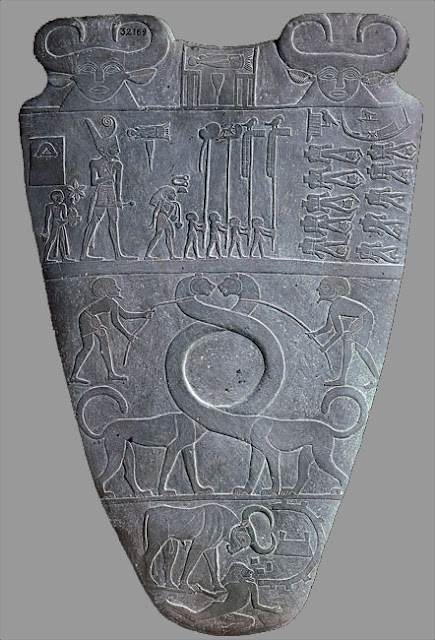Form: Palette of Narmer from Egypt's Dynasty 1 dated circa 3100 BCE is in low relief and made out of mudstone. It is stylized and subtractive with relatively little or no depth. It is fairly symmetrical with balanced features on both sides and stands approximately 25" in height. The Palette is about 6" thick and convex. It is has been carved in low relief on both sides. The figures are generally in composite view and it is highly stylized. In this view all the body's features but the torso are shown in profile, the torso exhibited from the frontal point of view.
http://art-and-art-history-academy.usefedora.com/
The palette's front features Narmer with the White Crown of Upper Egypt. Behind him is an attendant holding his sandals and to the right is a falcon holding a rope with a human head. The falcon is perched upon papyrus while Narmer is ready to bring his enemy down. Below Narmer are two dead people. On the back of the palette Narmer is wearing the Red Crown of Lower Egypt behind him is his attendant holding his sandals and in front of him are his minister of state and for men. In front of them are decapitated bodies with a falcon watching them. Below two men hold onto feline creatures who's necks are entwined around the indentation in the palette. Below, a bull out side of the gates of the city is harassing an enemy or is knocking down he walls of a city. The picture plane is divided in registers that define space and stories.
 Iconography: Stokstad refers to the composite view as a "memory image" in her section concerning "Representations of the Human Figure," Stokstad's discussion discusses this canon or formula of proportion as being fairly symbolic, therefore, the composite view can be both formal and iconic. When a figure, like the larger figure of the king, is displayed in such a way that all attributes of the physical body are shown at the same time. Composite view was often used to establish social/hierarchical status, which explains why Narmer is depicted in such a way. He was an Egyptian aristocrat. Also, the composite view may have been intended to portray perfection and thus enhance the image's supernatural power. Composite view would be then be really useful in tomb art, since the early Egyptians believed that the spirit of the dead could enter a secondary body in the afterlife.
Iconography: Stokstad refers to the composite view as a "memory image" in her section concerning "Representations of the Human Figure," Stokstad's discussion discusses this canon or formula of proportion as being fairly symbolic, therefore, the composite view can be both formal and iconic. When a figure, like the larger figure of the king, is displayed in such a way that all attributes of the physical body are shown at the same time. Composite view was often used to establish social/hierarchical status, which explains why Narmer is depicted in such a way. He was an Egyptian aristocrat. Also, the composite view may have been intended to portray perfection and thus enhance the image's supernatural power. Composite view would be then be really useful in tomb art, since the early Egyptians believed that the spirit of the dead could enter a secondary body in the afterlife.Similarly hieratic scale is both a formal device as well as iconographic. Usually, the larger the figure, the more important they were to society. Narmer is noticeably larger than the other figures and this suggests that their roles were more inferior.
The iconography of the palette is complex and somewhat relates to the development of the pictographic system of writing called hieroglyphics. The square at the top and in the middle on both sides of the palette and next to Narmer's head on the back of the palette is symbolic of the ruler's name. The fish symbolizes (nar) and the vertical chisel is a symbol for (mer). The cows on either side are a symbol for the goddess Hathor. The large figures of Narmer is a symbol of his power and divine status. The falcon is a symbol for the god Horus. The papyrus is a symbol of lower egypt. The four men in front of King Narmer on the back of the palette are holding things that maybe symbols of different regions of Egypt. The entwined necks of the felines may be a symbol of unity. King Narmer wearing both the White and Red Crowns symbolizes that he rules both Upper and lower Egypt. The Bull is another symbol of his power and virility.
Context: King Narmer who had been a minor official in Upper Egypt rose to power and conquered Lower Egypt around 3100 BCE. He and his successors: established a theocratic political system over the entire navigable length of the Nile. King Narmer either unified Upper and Lower Egypt or began the process of unification that was completed in the first dynasty. Palettes were used to grind pigments that were worn as eye paint. This eye paint was worn by both men and women to reduce infections and to reduce the glare of the sun.
http://art-and-art-history-academy.usefedora.com/





Hi friend
ReplyDeleteI'm sayed mahmoud - Egyptologist , I puplished myy article in Academia under the website of gaynor devenport , it is a new interpretation for the mace-head and the paleette of Namer, hope you read it
thank you
Sayed